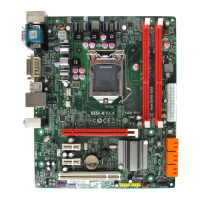
Do you have a question about the ECS H55H-M and is the answer not in the manual?
| Number of memory slots | 2 |
|---|---|
| Maximum internal memory | 8 GB |
| Processor socket | LGA 1156 (Socket H) |
| Processor manufacturer | Intel |
| S/PDIF out connector | Yes |
| Number of SATA connectors | 6 |
| USB 2.0 ports quantity | USB 2.0 ports have a data transmission speed of 480 Mbps, and are backwards compatible with USB 1.1 ports. You can connect all kinds of peripheral devices to them. |
| Ethernet LAN (RJ-45) ports | 1 |
| Firewire (IEEE 1394) ports | 0 |
| Audio chip | VIA VT1705 |
| Power source type | ATX |
| Audio output channels | 5.1 channels |
| Motherboard form factor | micro ATX |
| LAN controller | Atheros AR8131M |
| Networking features | Gigabit Ethernet |
| ACPI version | 3.0 |
| BIOS memory size | 16 Mbit |
| Depth | 200 mm |
|---|---|
| Width | 244 mm |
Comprehensive list of the motherboard's technical specifications and capabilities.
Essential safety guidelines for handling and installing motherboard components.
Step-by-step guide for correctly installing the CPU onto the motherboard.
Instructions for inserting DDR3 SDRAM modules into the motherboard slots.
Instructions for downloading and installing the latest BIOS version for system improvements.
Steps to diagnose and resolve issues when the PC fails to start after assembly.
Tips for troubleshooting issues that arise after the PC has been in use for some time.
A visual guide to systematically diagnose common PC startup problems.
